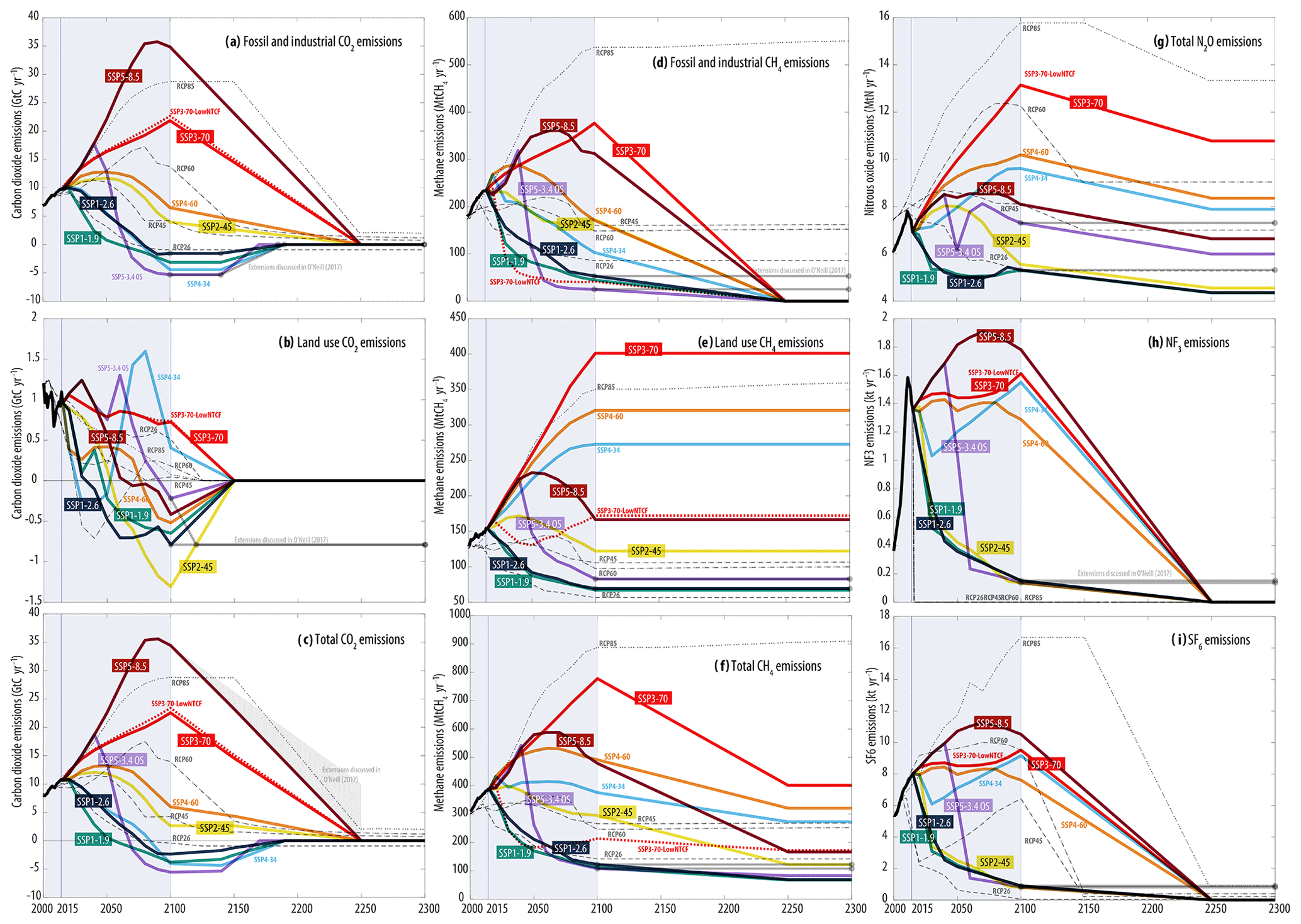Climate skeptics have new favorite graph; it shows the opposite of what they claim
Posted on 26 March 2025 by Zeke Hausfather
This is a re-post from the Climate Brink
Last September the Washington Post published an article about a new paper in Science by Emily Judd and colleagues. The WaPo article was detailed and nuanced, but led with the figure below, adapted from the paper:
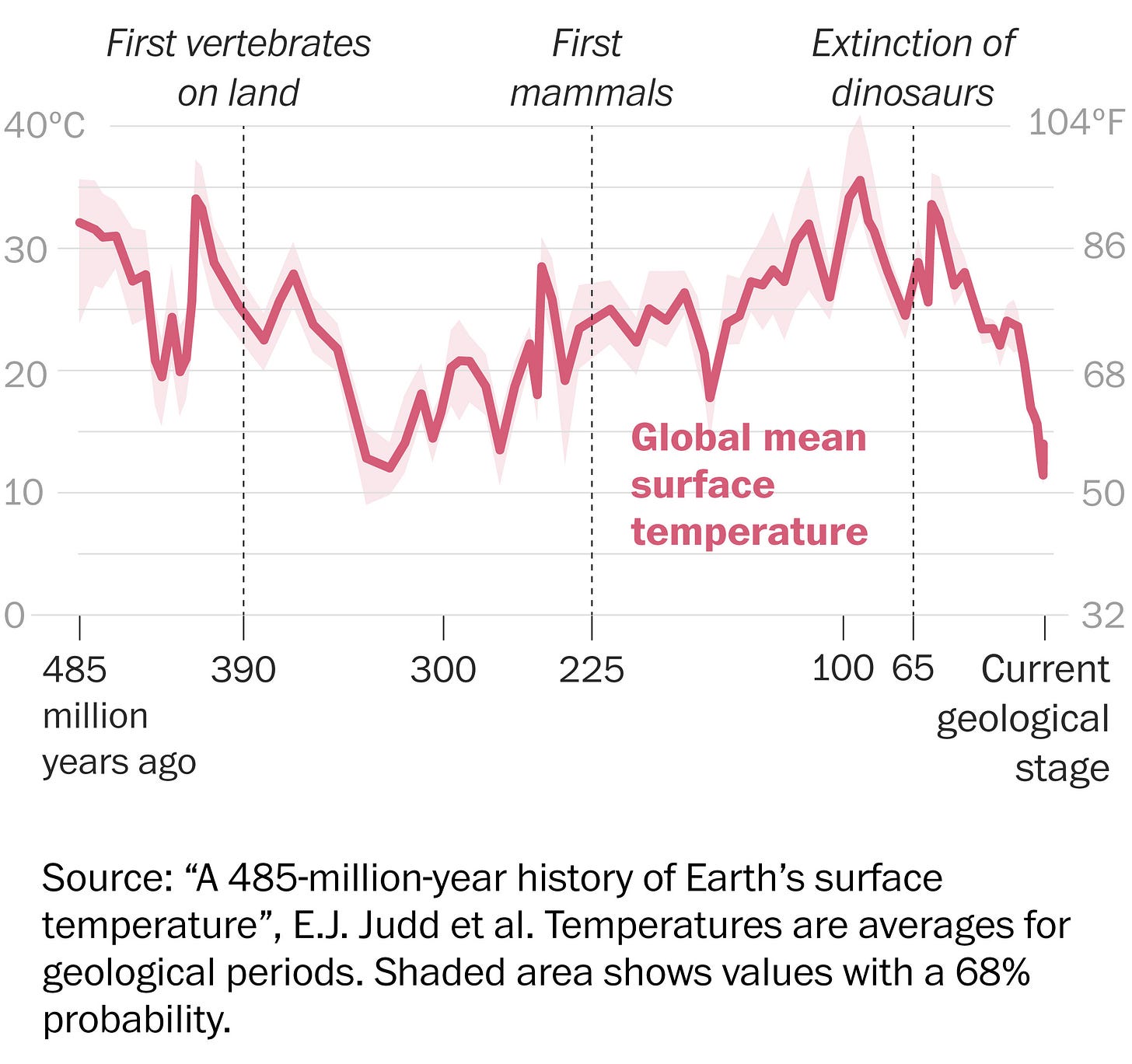
The internet, being less prone to detail and nuance, ran with the figure, with climate skeptics calling it their “new favorite graph” and reposting it everywhere, claiming that it shows the insignificance of recent human warming relative to the Earth’s long temperature history.
The furor over the graph reached its apogee in January when Joe Rogan showed it in a podcast interview with Mel Gibson, saying that “If you believe these silly people, way before human beings had ever existed, there's always this rise and fall. And this idea that the whole thing is based on carbon emissions from human beings is total bullshit. It's not true. Right. We might be having an effect, but we're having a small effect, a very small effect.”
The actual paper says otherwise
So we decided we’d do the barest amount of actual diligence on the claim. We read the actual paper (non-paywalled version here). And, lo and behold, we found that rather than dismissing the role of CO2 on longer-term changes in the Earth’s climate, it makes one of the strongest claims yet that “CO2 is the dominant driver of Phanerozoic climate [the past 485 million years], emphasizing the importance of this greenhouse gas in shaping Earth history.” The authors even express surprise that CO2 explains so much of the apparent temperature variation, and that solar variability does not have as dominant an effect.
It turns out that the Washington Post’s graphic only shows half the picture. Here is Figure 4 of the Judd et al 2024 paper, showing both temperature (the plot the WaPo recreated) and CO2 over the past 485 million years. For most of the record the two changed in lock-step, with hotter periods almost invariably having higher CO2 concentrations and cooler periods having lower CO2 concentrations (note that CO2 serves as both a forcing – e.g. during periods of excess volcanism – and a feedback to other external forcings during the Earth’s past).
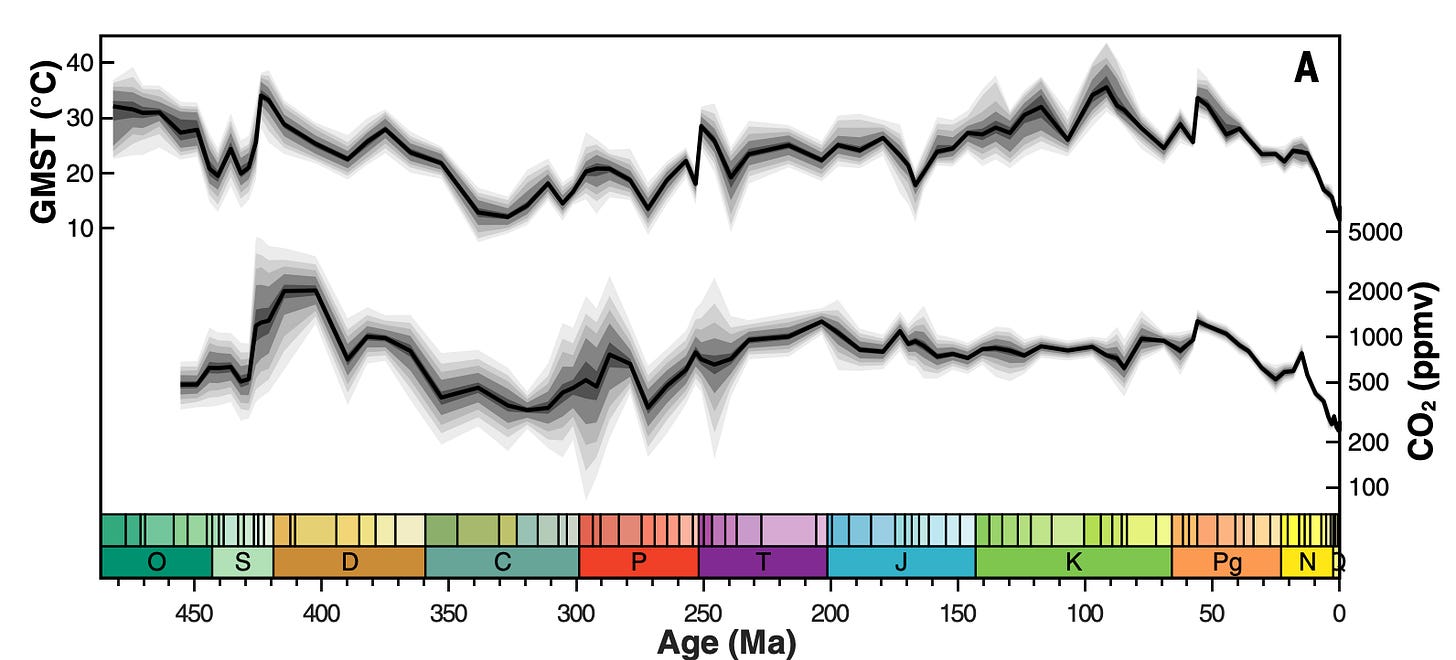
We also thought to ask the actual authors of the paper what they thought about how their work was being (mis)used in various corners of the internet.
Lead author Dr. Emily Judd replied (emphasis hers):
I’ve seen quite a bit of misinformation crop up surrounding our paper – particularly the claim that we (humans) have nothing to worry about, with respect to climate change, since the Earth has been warmer for much of the last half-billion years. I cannot stress enough how reductive and problematic this viewpoint is. The flaw in this logic boils down to two key points:
(1) the resilience of the planet does not directly translate our own species’ ability to adapt and thrive in the face of human-caused climate change, and
(2) the impact of anthropogenic climate change is (and will continue to be) determined by the rate of change (meaning how quickly CO2 and temperature change) much more than the absolute temperatures, themselves.…When we compare CO2 and temperature across the last half-billion years, we find a strong correlation between the two parameters, which indicates that CO2 has exerted a strong influence on global temperature not just today and in the recent past, but across the last 485 million years of Earth’s history.
Similarly, author Dr. Jessica Tierney told us:
Joe [Rogan] seems to be saying that because – geologically speaking – we are in a colder climate that we don’t have to worry about human-caused global warming. Nothing could be further from the truth. It certainly has been warmer that today in the deep geological past, but those past warm periods developed slowly over millions of years. As a consequence, life on Earth had time to adapt. The problem with current global warming is the speed. The warming that humans are causing is unbelievably fast, and so humans and the other forms of life that we share the planet with can’t fully adapt. In fact, rapid warmings in the geological past are often associated with mass extinctions – abrupt climate change is hard for life to tolerate. So that underlies the danger in allowing our climate to warm so fast right now.
What our study actually shows is that CO2 is the dominant control on Earth’s temperatures across geological timescales. Every time CO2 is high, temperatures are warm. So it follows naturally that, as humans emit more CO2, the climate warms. The study reinforces the strong connection between CO2 and climate change.
It’s not just how hot, but how fast
While Earth has experienced warmer periods in its deep past, the seriousness of climate change is defined by its pace. The warm temperatures in Earth’s past unfolded over millions of years, giving life ample time to evolve. In contrast, today's changes are happening at an unprecedented rate—within decades rather than millennia—leaving inadequate time for adaptation.
The geological record offers sobering evidence of what happens when climate change occurs too rapidly: mass extinctions.

The above figure plots surface temperature (black) for the past 485 million years along with mass extinction events (orange vertical lines). The timing of two events are coincident with rapid climate fluctuations:
-
The Late Ordovician mass extinction (440 million years ago) saw approximately 60% of marine species vanish.
-
The Permian-Triassic extinction (251 million years ago), often called "The Great Dying," eliminated 90% of all species during a period of dramatic climate change linked to volcanic CO? emissions.
This record demonstrates that climate change can have extreme consequences. Organisms don’t have time to adapt and risk extinction.
As Dr. Judd told us:
The geologic record has taught us that when CO2 and temperatures change slowly, organisms can keep pace with the environmental change – evolving, developing adaptations and/or migrating to new places. However, when CO2 and temperatures change rapidly, as is happening today due to anthropogenic emissions, evolution can’t keep pace with the environmental change. We’ve seen this before at the end of the Permian, due to widespread volcanism, and at the end of the Cretaceous, due to an asteroid impact – when the climate and the environment change rapidly, evolution simply can’t keep up.
What is happening today is particularly catastrophic because the organisms that exist evolved to tolerate the icy conditions of our modern planet – just like humans, they’re cold adapted. They (and we) are not equipped handle the warmer conditions and the rate of change is too fast for evolution to keep pace. Not only have humans evolved to tolerate colder conditions, we have also established our populations close to water sources and often near sea level. As we observe the Earth warming at a rapid pace within human time scales, we are faced with challenges such as more intense storms, more frequent and intense droughts (in some regions) and floods (in some regions), rising sea levels, and, ultimately, a reduction in habitable and arable land.
Carbon dioxide controls the climate
Another key insight from this record is the consistent relationship between atmospheric carbon dioxide levels and global temperatures across the geologic record. Throughout Earth's history, this correlation is remarkably clear: when CO? concentrations rise, temperatures follow.
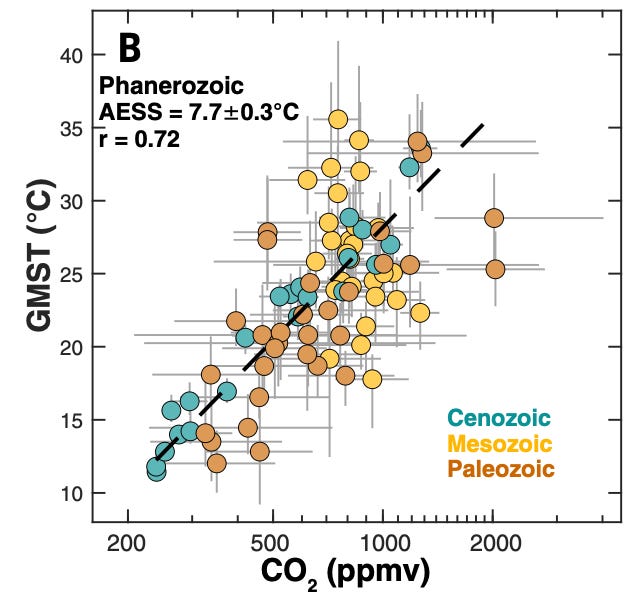
Humans have increased atmospheric CO? by approximately 50% in just 150 years—a mere instant on the geologic timeline. Predictably, temperatures have responded, with 2024 measuring 1.55°C warmer than pre-industrial levels.
So yes, Earth has been hotter, but the pace of climate change is more important than absolute temperature. Organisms today (humans included) have evolved in colder temperatures, and the geologic record shows us that rapid warming could devastate our cold-adapted ecosystems.
Note: This article is a collaboration between Zeke Hausfather and Devin Rand, a research scientist at Berkeley Earth.































 Arguments
Arguments


























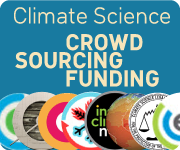

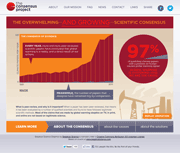
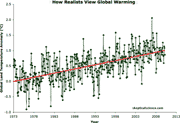
Great article!
The analogy I like to use to explain why the rate of warming is important is Speed Kills.
When exiting a freeway, you slow down from 60 mph (100 kmh) to rest in about 30 sec. This is a nice, reasonable rate of change. What happens if you speed up that rate of change by a factor of 100?
[BL] Link fixed...
I knew which graph just from the title after I commented on the original Washpost article here: www.washingtonpost.com/climate-environment/2024/09/19/earth-temperature-global-warming-planet/?commentID=3e500d42-0006-4924-a353-36bd06f848fb I won't repeat all my critiques, but here's the most important one: the paper doesn't support the claim of unprecedented warming. That was invented by the Post authors. That's particularly obvious after reading the supplemental: www.science.org/doi/suppl/10.1126/science.adk3705/suppl_file/science.adk3705_sm.pdf The data points for rapid transitions are much too sparse to compare to a century or so of manmade warming.
Eric@2, whether the label "unprecedented warming" is or is not warranted is kind of like debating whether the Category 5 Hurricane that just wiped out your town was or was not a hurricane of unprecedented strength. The current warming of 0.2C/decade (read here) is likely incompatible with organized human civilization and the well being of Earth's rich biodiversity. Let's not spend too much time debating terms and instead figure out what to do to slow down the rate of warming.
I agree with Eric that we dont have enough data points hundreds of millions of years ago to know if there was a single century or two of warming of several degrees. However the current rate of warming is unprecedented in the last 2,000 years and probably the last 10,000 years. We have enough fine grain detail and data points to know this and numerous studies on it. And its the stability of this period that human civilisation developed within. Billions people and their agiculture and infrastructure are most likely very reliant on this relative stability.
This is all being put at risk by politicians and other people that deny the climate problem and place their personal and unlimited wealth accumulation and tax cuts for millionaires and already profitable corporations above literally all other considerations. If this isn't an addiction, then what is?
Nigelj@4, I'm sure you're aware that using ice-core data, we have sufficient data going back more than a million years to say that the current warming is unprecedented back that far.
The reason that is important is that coming out of ice-age cycles (i.e., during deglaciation), warming occurs at a rate to which most of the biosphere can adapt. With the current warming occurring about 100 times faster than that deglaciation rate, many species will not be able to adapt fast enough. The faster we change temperature, the more stress it puts on the biosphere.
Nigelj@4, we love to rail at politicians, but remember that in countries with freely-elected leaders, we elect these people. The root of the problem still lies with us and the choices we make.
"The root of the problem still lies with us and the choices we make." and there's the crux of the issue- You would surely think where are the mass protests against this guaranteed existential threat from a too rapidly ever warming planet? The increasing instability to our food and water systems- the insurance/financial- political- pandemics and on and on. The flora and fauna are victims as too the human pollutors.
People dont want to lose their choices- the cars we drive, with the increasing "features"-the ailes in supermarkets for toothpastes or pet food or breakfast cereal-the endless fashion loop of clothing-the overwhelming desire for your children to become adults with a good job and a comfortable lifestyle and on and on. I cannot remember where I copied this next quote from but it describes some of my thoughts..
"Capitalism is not about a natural supply and demand. Capitalism is about MANUFACTURED demand, for which those who manufacture such demand, also "happen" to have a supply. There is little demand for weapons until the capitalists manufacture an international conflict. Most individuals don't need the vast majority of things they are told they should buy, so capitalists manufacture an insecurity in them so they feel inadequate without these trinkets.Bingo. And that "manufactured demand" is not only putting us in danger of serious military conflict, it's also RUINING the planet because we arent managing finite resources smartly.
I am not surprised that the paper’s presentation of 485 million years of temperature history was irrationally misinterpreted. Some people desperately seek any excuse to maintain their harmfully incorrect beliefs about climate science, and many other matters. They can be especially desperate to prolong or increase the benefits they can get from delaying the ‘responsible, ethical and moral’ corrections of harmful developed human beliefs and behaviour that climate science has identified.
The fact that human civilization has only existed in the last 10,000 years (less than 0.002% of the length of the chart) has to be ignored by some people to maintain their desired misunderstandings.
It took me less than a minute to find the following Phys.org report from 2021: Global temperatures over last 24,000 years show today's warming 'unprecedented'. It presents details of the temperatures in that tiny right-hand end of the misunderstood chart from the 485-million-year paper. (Note that the title includes a term that some people attempt to claim does not apply to the results of modern-day human impacts on the planet).
Undeniably, many people are easily tempted to believe misunderstandings about research results like this report. And, unfortunately, some people are so passionately emotionally invested in their misunderstandings that they powerfully resist attempts to get them to care to learn that their beliefs are ‘harmfully incorrect’.
Harmfully misleading pursuers of popularity and profit like Joe Rogan (and like Musk, and Trump, and all the people who bought memberships in Trump’s Mar-a-Lago Cult) are unlikely to be influenced by efforts to get them to learn that their preferred beliefs are harmful incorrect. They will behave like the following quote from this re-posted Climate Brink story.
The furor over the graph reached its apogee in January when Joe Rogan showed it in a podcast interview with Mel Gibson, saying that “If you believe these silly people, way before human beings had ever existed, there's always this rise and fall. And this idea that the whole thing is based on carbon emissions from human beings is total bullshit. It's not true. Right. We might be having an effect, but we're having a small effect, a very small effect.”
It is tempting to say that ‘all people in a democracy’ are to blame for the results of their collective leadership elections. But that is disrespectful of everyone who tried to help others learn to be less harmful and more helpful to Others. And it excuses the harmful misleading actions of the likes of Joe Rogan (and the likes of Donald Trump and Elon Musk).
It is important to understand that ‘pure democracy’ would result in the interests of ‘the controlling majority’ being justified regardless of the undeniable harms caused by those interests. Regardless of the socioeconomic-political system, there is a significant risk of harmful abusive actions dominating (winning) unless everyone is effectively governed by learning to be less harmful and more helpful to Others.
Ideally everyone would responsibly self-govern to be less harmful and more helpful to Others. But there will always be some people who need to be ‘governed by Others’.
prove we are smart@7
I do not disagree with your assessment that our capitalistic desires drive overconsumption.
But I think that even if you removed the capitalistic drive for overconsumption, there would remain a problem of nearly insurmountable size. Our natural, healthy desires to feed, clothe and shelter ourselves and to look after our children would be enough to cause environmental stress. It is a personal opinion, but I think that if we removed our insatiable capitalistic desires, AND turned down the global population from over 8 billion to something like 80 million, that then, and only then could we live in harmony with nature.
I feel this way because I am trying to live a sustainable life, but I am nowhere near sustainability and I don't know how to get there. Many of the things that make life worth living, such as hobbies and getting together with friends, increases GHG emissions. Should I give up that which makes life rich and fulfilling in the pursuit of reducing GHG emissions? Shall I become a hermit to reduce GHG emissions? Even writing this comment incurs GHG emissions. Every time I refresh my browser to read the responses to my comments I incur GHG emissions.
There are no easy answers.
Evan, your comment #3 is valid, that the effects matter more than the magnitude of warming or the rate of warming. But then in comment #5 you make a million year claim about warming (rate or magnitude or both). That claim is based on a single location using a single ice core, and there are many counterexamples like this:sa.indiaenvironmentportal.org.in/files/Evidence%20for%20warmer%20interglacials%20in%20East%20Antarctic.pdf
I have some issues with Holocene reconstructions that nigelj is alluding to in #4 but those quibbles (regarding spatial and temporal resolution) are not pertinent to the curve argument that this posting is about.
In general longer term claims like Post made (Post authors, not the scientists) such the 450 million year curve compared to present rate of warming are abstractions. They sound impressive until they are given a bit of scrutiny and then are very easily dismissed. Instead I would use a combo of your #3 and nigelj's #4.
Eric@10, yes, the ice cores give temperatures at just a single location. However, because CO2 is a long-lived greenhouse gas, we can use the CO2 record from a single ice core to reasonably represent the global CO2 concentration at any given time. Link the measured CO2 concentration to the science that relates atmospheric CO2 concentration to atmospheric temperature (i.e., the climate sensitivity), and we can use a single ice core to infer global temperatures. Because we have multiple ice cores dating back 400,000 years or so, we know with reasonably high confidence the temperature profile quite a ways back.
But the real point is that at a current rate of warming of 0.2C/decade, we are warming so much faster than any of the ice-core data sets record, that we are clearly warming at an unprecendented rate compared to the warming over the last 400,000 years or so. And unprecendented does not mean a factor of 2 or 3, but more like a factor of 100 or so. In short, we are warming so much faster than Earth has in the recent past, that it really is not productive to argue about semantics.
We are in deep trouble, and we have plenty of data sets with which to compare to support that claim. No, I have not provided links, but you seem very well informed about the history and science of ice cores (that is meant as a compliment), so that I assume you understand what I mean by CO2 being a long-lived greenhouse gas that distributes itself uniformly over the Earth.
If you contest the science that links CO2 to warming, then I will rest, because it is science that provides the critical link between what we can measure very well (i.e., CO2 concentrations from ice cores) and global temperatures.
Evan @ 5,
"Nigelj@4, I'm sure you're aware that using ice-core data, we have sufficient data going back more than a million years to say that the current warming is unprecedented back that far."
I was quoting from NASAs website and other studies I recall that the recent rate of warming is unprecedented in 10,000 years being the later part of the warming period coming out of the last glaciation. This period was very stable with just very slight warming.
However OPOF posts a more recent source I hadnt seen that the warming is unprecedented in 24,000 years being the full warming period coming out of the glaciation, so on that basis warming is very probably unprecedented in 2.6 million years ie: since the start of the most recent glaciation.
My understanding is we cant be certain warming is unprecedented going back tens of millions of year because of a lack of enough data. There could be a century buried away with high rates of warming of 1 degree or more per century, because we dont have enough data to be certain otherwise. This seems to be the point Eric is making.
The graph posted by OPOF going back about 30,000 years has error bars that seem to indicate its extremely unlikely there was a single century over the last 24,000 years with rates of warming of 1.5 degrees or more. Eric might want to look at the graph. I also think its obvious from the graph that warming since the industrial revolution is rapid compared to the post glacial warming and that is the main point rather than nit picking too much, along with the fact that the rapid warming currently is hard for species to adapt to.
I agree with the rest of the points you made.
nigel@12, I won't argue your points except to note the following.
My view of why we keep focusing on temperature reconstructions is to convince non-scientists that the current rate of warming really is unprecendented over a period of time we care about, and really is something we should be worried about.
But for anybody who appreciates climate science and the link between atmospheric CO2 concentrations and the coming climate "attractions", CO2 increasing at 2.5 ppm/year is about 200 times higher than it was coming out of the last deglaciation, when rates were more like 1 ppm/100 years. So let's round it off and just say that currently CO2 concentrations are increasing about 100 times faster than they were during the last deglaciation.
The ice-core data shows that over the last 400,000 years or more, CO2 has stayed within the range of 180 to 300 ppm. That we have increased CO2 by 100 ppm since the start of the Keeling Curve measurements, the fact that we are now at 420 ppm, and the fact that CO2 is currently increasing, on average, by 2.5 ppm/yr, should be all that anybody needs to know to understand that we are in deep doodoo. At least anybody who respects what climate science tells us about the link between CO2 concentrations and warming.
Evan @ 9, agreed. We would have to live very simply with little technology, and with a very small global population to be truly in harmony with nature. However I dont believe we have to be in perfect harmony with nature. We just have to ensure we aren't causing massive problems like climate change, the decline of pollinating insects, toxic pollution, needless waste, extravagant consumption levels like living in exceesively large homes. Sudies suggest an optimal global population is around 2 - 5 billion. Its all a compromise, but I'm ok with the fact its a compromise solution. Utopian solutions don't work anyway.
Thanks Evan for #11, I see your point. However my understanding is that climate sensitivity is not constant. This paper dspace.library.uu.nl/bitstream/handle/1874/358482/1.pdf?sequence=1 shows most of the factors affecting climate sensitivity in fig 1. The pertinent ones are decade time frames since we are comparing decades of human-created CO2 to past natural rises in CO2. Also we need to consider TCR rather than ECS with all the long term feedbacks: www.gfdl.noaa.gov/blog_held/3-transient-vs-equilibrium-climate-responses/ In short, variations in dust, vegetation and carbon cycle between the current time and the Eemian could result in a different transient or equilibrium climate sensivity.
That may make it difficult to compare the current rise in CO2 and Eemian (and prior) rates of rise in CO2 as proxies for rates of temperature rise. However getting back to nigelj #5, reiterated in #12, the rise from the LGM to the present (the chart linked by OPOF) that makes the present magnitude and rate unique in 24k years.
Eric@15, agree that climate response is not constant and that we need to consider long-term effects. However, my understanding from James Hansen is that the long-term climate sensitivity is higher than the commonly accepted value of 3, not lower (read here). An ECS value of 3 is bad enough. Higher values associated with longer-term feedbacks don't improve the picture.
But my point is this. Through the effect of Milankovitch cycles, the orbits of Saturn and Jupiter trigger complex feedback processes that cause CO2 to vary about 100 ppm over 100,000-year cycles (i.e., ice-age cycles). This results in sea level changes of 400 ft. This suggests that our biosphere is in a very delicate balance. Given that atmospheric CO2 concentrations have been 300 ppm or lower for 100's of thousands of years, given that CO2 is currently at 420 ppm and increasing at a rate of 2.5 ppm/year suggests we are in deep trouble. All of this discussion of proxies and whether we should use TCS or ECS seems to me to be a distraction from the central point that we are actively pushing nature way, way out of balance.
And we keep pushing.
Evan and nigelj,
Regarding a sustainable total global population.
I will try to connect my comment to the problem of misleading marketing by people who want to benefit from harmful fossil fuel use.
I agree that ‘capitalism’ is not the problem. The problem is ‘capitalism’ and other -isms not being effectively governed by learning to be less harmful and more helpful to Others. However, the capitalist systems do have the ‘problematic need’ for growth from increased population.
My understanding, based on a diversity of expert evaluations, is that many more than 80 million people can live sustainably on this amazing planet. The Wikipedia item for Sustainable Population is helpful. It includes the following: “Estimates [for a sustainable human population of Earth] vary widely, with estimates based on different figures ranging from 0.65 billion people [8 x 80 million] to 9.8 billion [almost 2 x 5 billion], with 8 billion people being a typical estimate.” Admittedly, some people would enjoy compromising what is considered to be acceptable ways of living so that fewer people can enjoy being more harmful than they ‘need to be’ (as long as they are among the fewer living that way).
The massive range of results summarized in the Wikipedia presentation is understandably largely due to ‘different ways of living’ being the basis for the different evaluations – which leads to the following question:
Should developed ways of living that require a reduction of the total population for those ways of living to be sustainably aspired to, and developed towards, be considered to be ‘superior or advanced ways of living’?
Desires for ‘less sustainable, more harmful, ways of living’ being manufactured by the actions of people competing for perceptions of superiority is a serious problem. It is particularly challenging to solve that problem while justifiably respecting the freedom of each person to believe and do as they please.
That leads to understanding that ‘personal vehicle driven urban sprawl development’ would mean a ‘lower sustainable total population’ than ‘more walkable higher density urban development with effective public transportation’ (refer to the recent SkS posting “Do Americans really want urban sprawl?”). Also, ‘modern rural living’ (with significant personal vehicle use to ‘enjoy life’) means an even lower total sustainable population.
In many regions of the planet capitalism appears to have manufactured/ developed desires and aspirations that are contrary to ‘more sustainable ways of living’ (that aligns with the quote shared by prove we are smart @7). A lack of responsible governing to develop sustainable improvements of ways of living, ways that would allow a larger number of people to enjoy living that way, is the problem.
The Planetary Boundaries evaluation by the Stockholm Resiliency Centre indicates that the current developed total impacts of the total global population significantly exceed many measures of sustainability. An obvious understanding is that reducing the number of less harmful people will not solve the current developed problem. The number of ‘most harmful people’ needs to be reduced. More harmful, less sustainable, ways of living and obtaining benefit need to be corrected or be justifiably restricted to benefit only the people who ‘legitimately need to temporarily benefit from more harmful actions’.
OPOF @17, good information. I will expand on what Im getting at. A very strict definition of sustainability - and being in perfect harmony with nature — means we would have to live like hunter gatherers or as close as possible. Ive seen an expert promote this. This means abandoning most industrial goods, huge reductions in energy use, stopping of all mining and abandoning of capitalism for some sort of shared ownership and adopting something like a strict form of organic farming. It would certainly require a global population towards the lower end of estimates of 500 million.
Such a thing would certainly be in perfect harmony with nature or very close, and would have a somewhat smaller environmental footprint, but it doesn't look practical or necessary to me and would be hard to live with and is unlikely to be adopted.
Theres a sensible compromise solution probably around a global population of around 2 billion, renewable energy, and a moderate reduction in levels of consumption, the use of walkable cities and modestly sized homes, etc. This will still have quite a large environmental footprint and resource shortages may eventually emerge but I would argue its capable of being sustained for a long time with minimum environmental damage. I think we just have to be sure we dont cause some sort of mass extinction or dangerous changes like the decline of pollinating insects. It's all still asking a lot of people. Evan made some good points on this.
In practical terms your preferred version of living sustainable living does seem roughly similar to mine anyway. So Im just sharing a perspective on the issue, not really arguing against you or your sources.
nigelj,
I agree that we substantially agree. One question I have is what would be the ways to transition from what has developed – nearly 9 billion with a very inequitable distribution of harmfulness and wealth plus total impacts that are well beyond being sustainable - to 2 billion living as you see being a sustainable future?
I will also clarify my perspective. (As an engineer with an MBA this is like the way I deal with an engineering/business challenge):
Specifically regarding a Sustainable Global Population:
Regarding the corrections required related to global warming and climate change impacts:
That perspective allows, and should encourage, improvements through scientific investigation and development of technological improvements ‘governed by learning to be less harmful and more helpful to Others’.
OPOF @19
"One question I have is what would be the ways to transition from what has developed – nearly 9 billion with a very inequitable distribution of harmfulness and wealth plus total impacts that are well beyond being sustainable - to 2 billion living as you see being a sustainable future?"
Just on the population question, a global population of 2 billion is likely to happen naturally due to the demographic transition, where people have chosen to have small families because they no longer need large families. In half the world the fertility rate is already 2.1 so its below replacement levels, and some countries have shrinking populations. This is likely to spread to the other half.
Of course none of this is guaranteed to happen, and it could be a very slow process. A fertility rate of 2.1 would lead to 2 billion people by about year 2700. A fertility rate of 1.5 by about 2050 which is plausible leads to 2 billion people by about 2200. I'm going by memory of a population calculator. Governmnets could speed it all up by ensuring women have good educations and human rights and contraceptives are easily and cheaply available, and not be tempted to panic and encourage shrinking populations to grow.
"Any ‘total global population’ up to 9.5 billion can be sustainable. It is simply a matter of keeping the sum of everybody’s impacts below the sustainable limits (the planetary boundaries and regional impact limits)."
It depends on how those planetary boundaries are defined and whether they are strong enough. I dont have the time right now to read the related studies, but my gut reaction is to be meaningful it would require policies of large reductions in consumption among high income people / countries and some reduction in consumption or only very slight increases in consumption in low income people / countries and this will all be very difficult to achieve. Therefore it makes sense to also aim to decrease the size of the global population in parallel. It may be easier getting the size of the population down. I doubt it would be any harder than reducing consumption levels. But essentially I think we need to try to do both as best we can, so decrease per capita levels of consumption and the size of the population.
Financial and resource inequality is a separate issue. I cant see a solution to this other than some sort of wealth tax, and tax payer funded redistribution of financial resources and even this will have to be limited in scope, to be politically viable. But this has worked quite well in some European countries to keep poverty rates and inequality within reasonable boundaries.
These policies are under attack by the populists and nationalists like Trump and their supporters. Hes trying to solve the low wage / inequality problem with tariffs but I cant see this working very well. Its most likely going to cause chaos, bring low wage assembly line jobs back to America, and cause inflation as experts have pointed out. It looks like the main beneficiaries of these policies would be billionaires, probably by design.
We are trying to stop dangerous levels of climate change thus keeping warming under 2 degrees and preferably under 1.5 degrees. It seems a valid response and framing of the issue. I think the same should apply to other environmental problems and also social and economic problems. We need to define and stop dangerous problems and changes. Part of this environmentally is ensuring we dont cross planetary boundaries. I think this is all a better approach than utopian style socio economic system solutions. But I could be wrong about that.
nigelj,
We do indeed substantially agree. The system change I advocate for is increased governing by the pursuit of learning to be less harmful and more helpful to Others, which would develop systemic changes to increase the likelihood of that type of governing occurring. And that ‘improved governing of the developed system’ is what would produce the corrections and improvements of what has currently developed you mention. And all of that is aligned with, can be seen to be addressed by, the Sustainable Development Goals. (also a different presentation of the 17 SDG goals).
Continuing with the developed systems simply driven by the pursuit of ‘potential personal benefit, popularity and profitability’ without being governed by learning to be less harmful and more helpful to Others will only make things worse, in more ways than climate change impacts, while many people are misled to believe that things are getting better (or that there is no problem).
I will note one subtle difference. I try to promote ‘equitable’ not ‘equal’. In some cases ‘equal opportunity and equal treatment’ are ‘equitable’. But equitable recognizes that a diversity of interests can result in equitable, but different, degrees of recognition and reward. And, of course, harmful actions deserve ‘equitable penalty’ in spite of potentially being more popular or profitable (by equitable, I mean a higher penalty for higher status people, people who should know better and could behave less harmfully)
nigelj,
A reduced global total population would definitely improve the ability of all humans on this amazing planet to sustainably enjoy better lives, now and into the distant future.
However, some people are opposed to, or unaware of, the fundamental benefit of fewer concurrently living people, regionally as well as globally. Fewer people would allow more sustainable negative impacts per person to meet the following common sense rule: (average impacts per person) X (number of people) < Sustainable total impacts
This recent BBC – In Depth article “The influencers who want the world to have more babies - and say the White House is on their side” is about beliefs that ignore or conflict with that common sense understanding. Those beliefs can currently be considered to be ‘of limited influence’. However, the current White House, and other institutions governed by the current version of the US Republican Party, is now significantly influenced by misunderstandings that were considered to be extreme fringe beliefs 10 years ago.
And a scary reality presented in the article is the following quotes of statements made by the ‘pronatalism promoter’:
"The easiest way to [spread the word about pronatalism] was to turn ourselves into a meme... If we take a reasonable approach to things and say things are nuanced, nobody engages. And then we go and say something outrageous and offensive and everyone's into it."
...
"We are a coalition of people who are incredibly different in our philosophies, our theological beliefs, our family structures," says Malcolm. "But the one thing we agree on is that our core enemy is the urban monoculture; the leftist unifying culture."
The following parts of the article are also a concern:
[JD]Vance has often spoken about the need to fix a "broken culture" that is tearing the US family apart, by undermining men.
In a recent interview, he said: "We actually think God made male and female for a purpose and we want you guys to thrive as young men and young women and we're going to help with our public policy to make it possible to do that."
This idea has been echoed in pronatalist circles.
"Vance is a vocal pronatalist," says Rachel Cohen, policy correspondent at Vox. "Trump himself campaigned on implementing a new "baby boom" and last week he declared himself the 'fertilisation president'."
...
Their [pronatalism promoters] connection to power is thanks to the so-called tech right, a reactionary movement against liberalism led by some of the most powerful people in Silicon Valley. Those in the tech right include Paypal co-founder Peter Thiel – who sponsored Vance's Senate race and has invested in fertility technology – and venture capitalists David Sacks and Marc Andreessen.
My semi-conspiracy theory, supported to some degree by the evidence, about the current version of the US Republican Party is that the fossil fuel interests who aggressively and abusively pursue their interests could only ‘sustain’ protection of their harmful interests by winning control over governing institutions. Increased awareness and improved understanding of climate science forced them to try to appeal to other harmful misunderstandings in their desperate attempts to ‘sustain’ their understandably harmful interests. And the groups they appealed to have developed more harmful influence, while ‘sustaining’ the harmful fossil fuel interests.
People who want more people born, especially those who want more of their type than Other types, seem to be the type that the harmful fossil fuelers, and the other harmful interests they have gathered support from, would try to appeal to in order to ‘collectively sustain’ their harmful interests.
Note: I admit to also wanting ‘more of a certain type of people’. I want more people who pursue learning to be less harmful and more helpful to others. That may be ‘divisive’. But it is arguably ‘a good divisiveness’.
[BL] Gentlemen: this is all getting rather off topic. Please wrap it up...
The weekly news round-up is more suitable as a general discussion area, if you want to move it.
OPOF @21
I go along with your philosophical position on system change etc,etc.
-------------------
OPOF @22
"A reduced global total population would definitely improve the ability of all humans on this amazing planet to sustainably enjoy better lives, now and into the distant future."
Exactly. Warming projections are based on business as usual population growth so only slowing mildly. Any way we can get that growth to slow quicker, will help the climate issue.
"This recent BBC – In Depth article “The influencers who want the world to have more babies - and say the White House is on their side” is about beliefs that ignore or conflict with that common sense understanding...."
Yes and its frustrating. This is why I suggested a declining population is not guaranteed (although personally I think population will still decline). There are forces in opposition to a smaller population mostly 1) people worried about the economics of the transition period of declining numbers of young people having to support an aging population tending to live longer and 2)people driven by the bible "go forth and multiply" and 3) the natural instinct to have large families is strong in some people even although it no longer makes much economic sense in developed countries. 4) people who tend to think more people is just good economically. 5) people worried about their culture losing dominance
And I can acknowledge the economic arguments and at least understand the religious and cultural arguments. But I think they arent very good arguments overall, and they will all still loose the argument because even in countries where governments have tried to encourage or financially incentivise large families it hasnt worked - people continue to prefer small families. There are examples in SE Asia easily googled. And family size is decling even in Catholic and Islamic countries. So I'm not that worried about Vance backing large families.
"[JD]Vance has often spoken about the need to fix a "broken culture" that is tearing the US family apart, by undermining men."
This appears to mean men are being underminded because they can no longer exploit, abuse, control and discriminate against women. Or because society now accepts trangender people. Vance and his ilk are never able to provide any other reasons of any significance.
"My semi-conspiracy theory......"
Something like that process is definitely going on. I dont think you have quite nailed it completely, but I cant immediately improve on it.
I tend to think that what is happening at the most general level in society is theres a unfortunate conservative backlash against gobilisation, which tends to have a liberal agenda, and which I broadly support. But it does have a few downsides which has left it open to attack.
The emergent conservative camp wants a return to economic protectionism, traditional family values, fossil fuels , and attracts people with largely traditionalist leaning values like that. There is no sign of much of a compromise solution emerging. Its very much armed and angry camps.
I think we have to stand up for the values we believe in and argue why, and also be open to understanding valid criticisms of our own positions. For example the Democrats proposed some truly stupid ideas like defunding the police. I guess it was an emotive reaction to police abuses but its still stupid.
"Note: I admit to also wanting ‘more of a certain type of people’. I want more people who pursue learning to be less harmful and more helpful to others. That may be ‘divisive’. But it is arguably ‘a good divisiveness’."
Agreed. And this is an example of promoting values we believe in. I dont see what more we can do. We have to take a stand, but without being closed minded about valid criticisms either. But sometimes I think liberals are a bit too polite - most of Trumps policies look idiotic to me and we have to sometimes call a spade a spade.
Moderator sorry. I agree it is a bit off topic. Your comment wasn't there when I posted. I won't continue further on this thread.
I have continued this discussion on the 2025 SkS Weekly Climate Change & Global Warming News Roundup #14
Hi all,
I am absolute green when it comes to topic of Climate research (which is obviously not my field) and trying to make sense of some information presented to general public. I am writing here as I'd like your help with navigating this as it seems to me a bit contradictive with presented "news of the day".
If you navigate to the https://science.nasa.gov/climate-change/, there are two data points that are interesting to me:
1. current CO2 ppm = 430
2. increase of GMST of 1.5 degree C since pre-industry era.
What puzzles me, why is this so important to call for crisis mode?
When I look at the Judd's graph no. 2 I am reading that the planet was operating during The Mesozoic Era, which we know was lush, green and supported living of megafauna, on levels of CO2 between 500-2000ppm and with temperature s significantly higher comparing to current time. I am reading the graph as a path from local minimum and not as a path to glabal maximum, when it comes to GMST. I do understand the problem of how rapid is the incremental temperature increase, but don't see the issue of the increase itself.
In the context of Judd's graph, isn't the graphe used at https://science.nasa.gov/climate-change/evidence/ just pure scaremongring?
If you take 800,000 years, the CO2 ppm looks like massive spike, in the graph. But when you take the context of millions of years as Judd does, this increase is well.. insignificant.
What am I missing? Why the panic and crisis mode?
Thanks!
RegalNose @ 26:
The OP mentions the concern about rapid changes. Do not dismiss that concern lightly.
...but with regard to the long-term record, and the Mesozoic period in particular:
In the next 75 years or so, a metre of sea level rise is a reasonable expectation. That will lead to a lot of new coastal flooding (already beginning), at significant cost (either to prevent, mitigate, or move away from).
In the longer term (centuries), a complete loss of land ice in a Cenozoic-like climate would lead to an 80m rise in sea levels. Here is a map (from this web site, where you can see a larger image) of how much flooding is likely. Are there any portions of that flooded coastal zone that you would like to see preserved?
RegalNose @26 [and to add to Bob Loblaw's comment] :
What are you missing?
Many things, it seems (including biological evolution).
And you are missing the meaning of "crisis" ~ a delightful word which covers a broad spectrum of possibilities, and is often played with by politicians & scammers.
The scammers want you to feel panic, so that you take immediate (but unwise) action of some sort. And some politicians use that approach too ~ for their own benefit.
Other politicians go the opposite way, and say there is no immediate crisis . . . and tell you to relax and take no action at all. Even if your common sense tells you it would be a good idea to start tackling a problem which has obviously been developing.
Analogy : You have been checking your car engine oil level daily, and you keep finding that you need to top up the oil by a quart every week. Is this a crisis ~ obviously not an immediate crisis . . . and yet a wise man would quickly consult a car mechanic and decide what action to take to tackle the engine problem. Not put things off until the middle of next year.
RegalNose : What is your idea of "crisis" ?
The planet was lush and green very shortly after the end of the last ice age, when CO2 was less than 300ppm. In every region where the avilability of water made their existence possible, forests grew. They covered an immense area of the globe before humans started cutting them down and slashing/burning. Megafauna existed also and was in fact richer than now, even during the ice age: Mammoths, whooly rhinos, dire wolves, cave lions, megacerops, smilodon, cave bears, etc, etc.
Humans are an enormously powerful factor constraining the existence, abundance and diversity of life. Humans precipitated the disappearance of the megafauna of the late quaternary. Currently, life is subjected to all the "normal" natural stressors and all the human made ones as well. Without humans, it is very likely that after a few tens of thousands of years, life would be green and lush, rife with megafauna, under the future climatic conditions afforded by 500ppm of CO2. There is absolutely no chance of that happening with 8 to 10 billions of humans inhabiting the planet. None whatsoever.
RegalNose@26,
In the context of Judd et al (2024)'s graph below (Fig4a in the OP above),
you ask - Isn't the NASA graph (below)
just pure scaremongring?
You ask "What am I missing? Why the panic and crisis mode?"
The OP above does not really answer your question of why CO2 should put us humans into a panic mode.
❶ The OP is firstly addressing the misuse of the Judd et al findings, being converted into total nonsense. It is, of course, difficult to nail down 'total nonsense'. ❷ Secondly, the OP chats about the threat of our CO2 to natural life on Earth rathert than the treat to humanity. ❸ That is not to say we humans should not be panicking.
❶ That first point, the OP presents an exemplar piece of 'total nonsense' which says "There's always this rise and fall." The context here implies it is the global temperatures they are saying "always ... rise and fall."
They continue:-
This quote is 'total nonsense' as the findings of Judd et al, the evidence they are presumably presenting, says the exact opposite. Judd et al say it is CO2 on which the "whole thing is based". From their abstract:-
And the present-day big actor driving the 'whole thing', the startling rise in CO2 NASA graph above, that is the 'human beings'. This 'whole thing' is not "very small".
Additionally, Judd et al finding "an apparent Earth system sensitivity of ~8°C" suggests the effect is far from "very small" in terms of global temperature.
❷ The threat to nature from to the CO2-rise being so rapid is a major part of the above OP. Perhaps to add a little colour, 56 million years ago the Paleocene–Eocene Thermal Maximum (PETM) was caused by CO2 rising from ~800ppm to ~2,000ppm. The climatic forcing would be the same if we today allow CO2 to rise to 690ppm (and no other GHG increases - accounting for other GHGs, the equivalent would be perhaps 520ppm).
The PETM was not a massive event in historical climate or ecology but it did have pretty big impacts. Consider horses - they shrank to the size of large dogs to cope with the heat. The PETM is often held up as the nearest example of what we are stoking with our man-made climate change. But there is one stark difference. The PETM warming took something like 25,000 years. Our warming is happening 100-times quicker. The sixth mass extinction event which humanity is already threatening with other activities will be a certainty if our warming gets anywhere close to rivalling the PETM's +6ºC.
❸ But we humans are an adaptable species. However the problems are this.
(1) We a very numerous species that relies on a lot of real-estate. Loss of big portions of that real-estate (or even just the projected loss of it) will have big big geo-political consequences. If we could all pull together and address the problems, that may not be so disastrous. But we won't. And I'd imagine climate-change-mitigation measures will not be such a high priority when the world economy collapses and wars of national survival break out.
(2) The climatology cannot tell us how long we can keep melting Greenland to prevent 20ft of sea level rise becoming inevitable, or when the AMOC will disappear plumging Europe into the deep freeze, or when the cloud feedbacks over the Pacific will add another +3ºC to the warming, etc. The +2ºC limit to the warming was dropped in favour of +1.5ºC because tipping-points such as these could potentially be triggered below +2ºC.
I hope that goes some way to explaining "the panic and crisis mode."
MA Rodger,
I read Judd et al. I have not previously seen an Earth Syatem Sensitivity of 8C. Hanson has long estimated ESS of 6C. If ESS is 8C we are leaving a super duper mess for our children. And the changes from 1.4 C are much higher than scientists thought they would be.
michael sweet @31,
A few thoughts about this +8°C ESS finding (actually it's AESS, taking the increasing solar energy into account).
(1) Hansen has indeed proposed a lower value, famously the graphic below from Hansen & Sato (2012) which even pre-dates the term ESS.
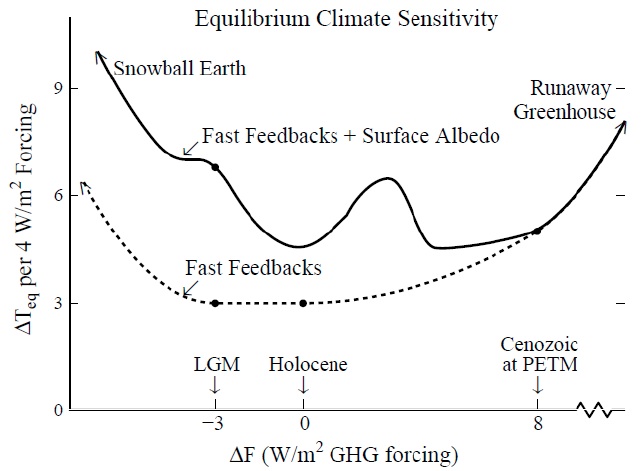
(2) Judd et al (2025) does say its constant ESS=+8°C finding is at odds with other work, but doesn't properly set all this out. For instance, they don't [ro[er;y review CenCO2PIP (2024) who find ESS "generally within the range of 5° to 8°C—patterns consistent with most prior work." I think all would agree that we haven't found a difinitive value for ESS although it will be higher than ECS.
(3) The Earth System equilibrium is very slow to arrive so the opportunity to keep AGW below +1.5°C in the long terms is surely far less of an issue than the shorter-term century-scale AGW.
That is, if CO2 will be three-quarters sucked from the atmosphere over a millenium, the CO2 forcing from modern CO2 emissions (with Af = ~50%) will be halved during the next 1,000 years, the sort of timescale that ESS arrives in. So if ESS ≤ 2 x ECS, it is the shorter timescales we need to worry about regarding temperature. SLR would likely be a good reason for giving natural CO2 draw-down a healthy hepling hand. And the technology to effortlessly do that will not be that long in coming.
(4) But on that point of a future 'effortless' techno-fix for excess CO2, I am always surprised that the post-2100 parts of the IPCC scenatios are not better known. The graphic below is Fig 2 from Meinshausen et al (2020) 'The shared socio-economic pathway (SSP) greenhouse gas concentrations and their extensions to AD2500'. The thumbnail bottom left-hand graph shows net CO2 emissions for scenario-various and if you scale SSP1-1.9 (a scenario which we should be trying to follow), the negative net emissions post-2050 equal all the FF & LUC emissions 2007-2050. That is something I find scary.
